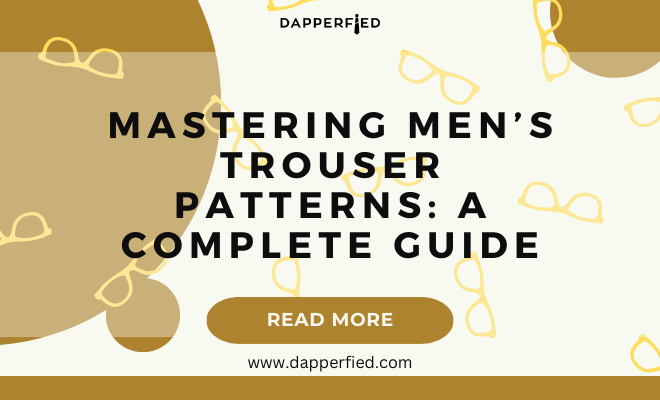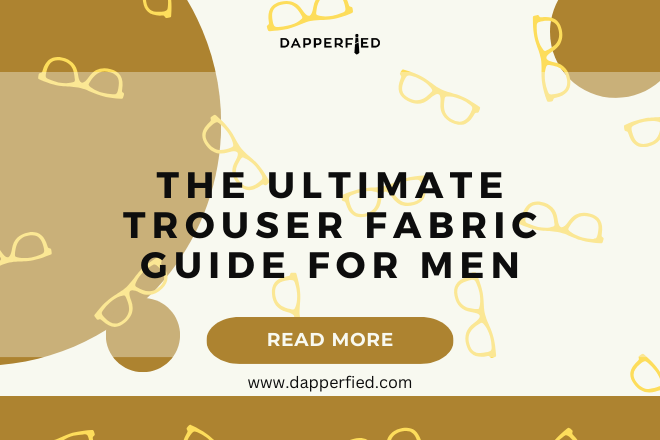
Men's Style
Mastering Men’s Trouser Patterns: A Complete Guide
When it comes to men’s trousers, there are a variety of patterns to choose from, each with its own unique style and characteristics. Some of the most popular trouser patterns include pinstripes, checks, plaids, houndstooth, herringbone, and windowpane. Pinstripes are thin vertical stripes that run down the length of the trousers and are often associated with formal business attire. Checks and plaids are characterized by intersecting horizontal and vertical lines, with checks being smaller and plaids being larger and more colorful. Houndstooth is a distinctive pattern that features broken checks in a two-tone design, while herringbone consists of a distinctive V-shaped weaving pattern. Windowpane is a pattern that features large, square-shaped checks that resemble the panes of a window.
Each trouser pattern has its own unique history and connotations. For example, pinstripes are often associated with Wall Street and corporate business attire, while houndstooth has its roots in traditional Scottish textiles. Understanding the different trouser patterns can help you make informed choices when it comes to selecting the right style for your body type and personal preferences.
Key Takeaways
- Understanding Different Men’s Trouser Patterns
- Choosing the Right Trouser Pattern for Your Body Type
- How to Style Different Men’s Trouser Patterns
- Mastering the Art of Mixing and Matching Trouser Patterns
- Tips for Tailoring Men’s Trousers to Fit Perfectly
- Incorporating Trendy Trouser Patterns into Your Wardrobe
- Maintaining and Caring for Men’s Trousers with Different Patterns
Choosing the Right Trouser Pattern for Your Body Type
When it comes to choosing the right trouser pattern for your body type, it’s important to consider both the scale of the pattern and your own proportions. For example, if you have a larger frame, you may want to opt for larger patterns such as plaids or windowpane, as these can help balance out your proportions. On the other hand, if you have a smaller frame, you may want to choose smaller patterns such as pinstripes or houndstooth, as these can help create the illusion of added bulk.
In addition to scale, it’s also important to consider the color and contrast of the pattern. Darker colors and higher contrast patterns can create a slimming effect, while lighter colors and lower contrast patterns can draw attention to specific areas. For example, if you have a larger midsection, you may want to avoid bold patterns in that area and instead opt for a more subtle pattern or solid color. Ultimately, the key is to choose a trouser pattern that complements your body type and personal style while also taking into account the occasion and formality of the event.
How to Style Different Men’s Trouser Patterns
Styling different men’s trouser patterns can be a fun and creative way to express your personal style. When it comes to pinstripes, these trousers are often associated with formal business attire and can be paired with a crisp dress shirt and blazer for a polished look. For a more casual take on pinstripes, you can pair them with a knit sweater or polo shirt for a relaxed yet sophisticated ensemble.
Checks and plaids are versatile patterns that can be styled in a variety of ways. For a classic look, pair check or plaid trousers with a solid-colored dress shirt and coordinating blazer. For a more casual look, you can pair them with a denim or chambray shirt for a laid-back yet stylish outfit. Houndstooth and herringbone trousers are perfect for adding texture and visual interest to your outfit. These patterns can be styled with a solid-colored sweater or jacket for a timeless look that works for both casual and formal occasions.
Windowpane trousers are a bold choice that can make a statement. To style these trousers, keep the rest of your outfit simple and let the pattern take center stage. Pair them with a solid-colored dress shirt and coordinating blazer for a sophisticated look that is sure to turn heads.
Mastering the Art of Mixing and Matching Trouser Patterns
| Trouser Pattern | Description |
|---|---|
| Stripes | Vertical or horizontal lines of varying thickness |
| Plaid | Intersecting vertical and horizontal lines forming a checkered pattern |
| Houndstooth | Broken checkered pattern resembling a dog’s tooth |
| Polka Dots | Circular pattern of varying sizes |
| Geometric | Abstract patterns such as triangles, squares, or diamonds |
Mastering the art of mixing and matching trouser patterns can take your style to the next level. When it comes to mixing patterns, it’s important to consider scale and contrast. Pairing two patterns of similar scale can create a harmonious look, while pairing patterns of different scales can create visual interest. For example, you can pair a small-scale pinstripe trouser with a larger-scale plaid blazer for a stylish yet balanced ensemble.
In addition to scale, it’s also important to consider color and contrast when mixing patterns. Pairing patterns with similar color palettes can create a cohesive look, while pairing contrasting colors can create a bold statement. For example, you can pair a navy pinstripe trouser with a light blue check shirt for a classic and sophisticated look.
When mixing patterns, it’s important to let one pattern take center stage while keeping the other patterns more subdued. For example, if you’re wearing patterned trousers, opt for a solid-colored shirt or jacket to balance out the look. Alternatively, if you’re wearing a patterned blazer, pair it with solid-colored trousers to keep the focus on the jacket.
Tips for Tailoring Men’s Trousers to Fit Perfectly
Tailoring men’s trousers to fit perfectly is essential for achieving a polished and put-together look. When it comes to tailoring trousers, it’s important to pay attention to the fit of the waist, seat, thighs, and length. The waistband should sit comfortably at your natural waist without being too tight or too loose. The seat should fit smoothly without any excess fabric or pulling, while the thighs should have enough room for movement without being too baggy.
In terms of length, trousers should break just above the shoe without creating any pooling or dragging on the ground. If you prefer a more modern look, you can opt for a slightly shorter length that hits just above the ankle. Additionally, it’s important to pay attention to the taper of the trousers, as this can affect the overall silhouette. Trousers should have a slight taper from the knee down to create a clean and streamlined look.
When it comes to tailoring trouser patterns, it’s important to pay attention to pattern matching. Pattern matching involves aligning the pattern at the seams so that it appears seamless and continuous. This attention to detail can elevate the overall look of the trousers and create a more polished appearance.
Incorporating Trendy Trouser Patterns into Your Wardrobe

Incorporating trendy trouser patterns into your wardrobe is a great way to add personality and flair to your outfits. One trendy trouser pattern that has been gaining popularity is the wide-leg trouser. Wide-leg trousers offer a relaxed and modern silhouette that can be styled in a variety of ways. Pair them with a fitted t-shirt or sweater for a contemporary look, or dress them up with a tailored blazer for a more formal ensemble.

Another trendy trouser pattern is the cropped trouser. Cropped trousers offer a modern and fashion-forward look that is perfect for showcasing stylish footwear. Pair them with loafers or sneakers for a casual yet polished outfit, or dress them up with oxfords or brogues for a more formal look.
Printed trousers are another trendy option that can add visual interest to your wardrobe. From bold florals to geometric prints, there are endless options to choose from when it comes to printed trousers. Pair them with neutral-colored tops and jackets to let the pattern take center stage, or mix them with other patterns for a fashion-forward look.
Maintaining and Caring for Men’s Trousers with Different Patterns
Maintaining and caring for men’s trousers with different patterns is essential for preserving their quality and appearance. When it comes to washing patterned trousers, it’s important to follow the care instructions on the label to ensure that they retain their shape and color. In general, it’s best to wash patterned trousers in cold water on a gentle cycle to prevent fading and shrinking.
When it comes to drying patterned trousers, it’s best to air dry them on a flat surface to prevent stretching or misshaping. Avoid hanging patterned trousers on hangers as this can cause them to lose their shape over time. If necessary, you can use a steamer or iron on low heat to remove any wrinkles or creases from patterned trousers.
In addition to washing and drying, it’s important to store patterned trousers properly to prevent damage. Hang them on sturdy wooden or padded hangers to maintain their shape and prevent creasing. If you need to fold patterned trousers for storage or travel, be sure to fold them along the seams to prevent creasing in the fabric.
By understanding different men’s trouser patterns, choosing the right pattern for your body type, styling them in various ways, mastering mixing and matching patterns, tailoring them perfectly, incorporating trendy patterns into your wardrobe, and maintaining their quality through proper care, you can elevate your style game and make a lasting impression with your outfits. Whether you prefer classic pinstripes or bold windowpane checks, there’s a trouser pattern out there for every style preference and occasion. With these tips and tricks in mind, you’ll be well-equipped to navigate the world of men’s trouser patterns with confidence and style.
If you’re interested in expanding your knowledge of men’s fashion, you might want to check out this article on men’s designer jackets. It’s a great complement to the Men’s Trouser Pattern Guide, offering insights into another essential aspect of men’s style.
FAQs
What are the common types of men’s trouser patterns?
There are several common types of men’s trouser patterns, including straight leg, slim fit, bootcut, relaxed fit, and tapered.

What is the difference between straight leg and slim fit trouser patterns?
Straight leg trousers have a consistent width from the thigh to the ankle, while slim fit trousers are narrower through the thigh and taper towards the ankle.
How do I choose the right trouser pattern for my body type?
It’s important to consider your body type when choosing a trouser pattern. For example, slim fit trousers are best for slender builds, while relaxed fit trousers are better for those with a larger build.
What is the best fabric for men’s trousers?
Common fabrics for men’s trousers include cotton, wool, and blends of these materials. The best fabric for you will depend on the season, occasion, and personal preference.
Can I alter a trouser pattern to fit my specific measurements?
Yes, many trouser patterns can be altered to fit your specific measurements. It’s important to take accurate measurements and make adjustments accordingly.
Are there different trouser patterns for casual and formal wear?
Yes, there are different trouser patterns for casual and formal wear. For example, dress trousers typically have a more tailored fit, while casual trousers may have a more relaxed fit.















